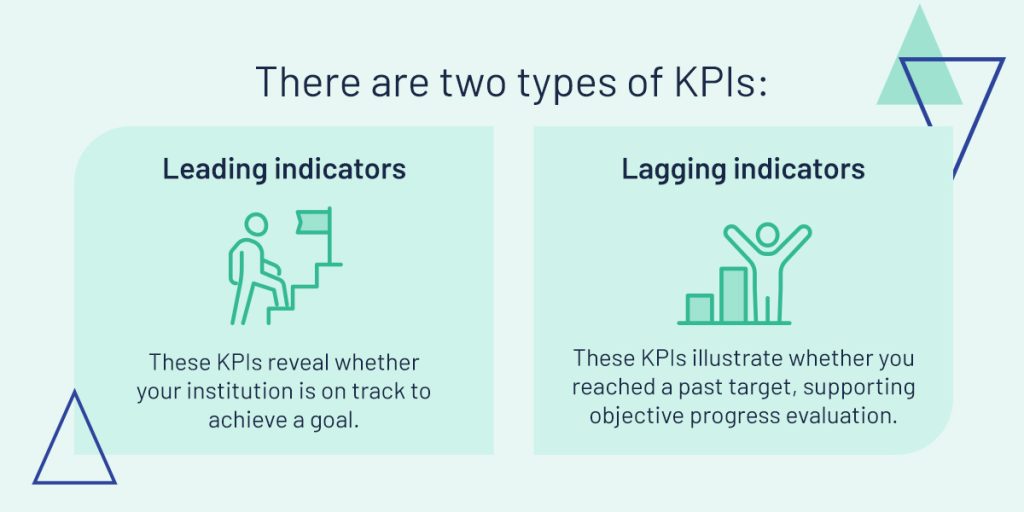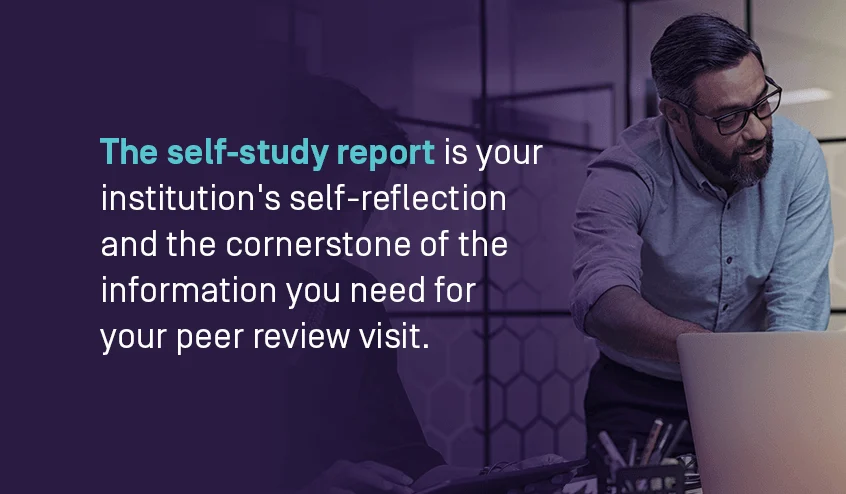
Key performance indicators (KPIs) provide higher education institutions with meaningful metrics of progress. Colleges use this information to boost retention rates, increase productivity, and drive change. The data you collect can influence changes in marketing, financing, classroom structure, curriculum quality, and student and staff performance. However, many community college administrators are unsure how to guide the development and implementation of KPIs.
Understanding key performance indicators and which ones will benefit your institution is the first step toward collecting meaningful information. In this guide, you’ll discover how to develop key performance indicators for community colleges.
What is a key performance indicator?
A KPI is a performance metric you can measure and analyze over time. A KPI differs from a goal, as a goal is what you aim to achieve, while a KPI is what you measure to check you’re achieving it. If your goal is to improve your institution-wide retention rates by 10 percent over the next two academic years, annual institutional, program, and course retention rates are crucial KPIs to measure.

There are two types of KPIs:
- Leading indicators: These KPIs reveal whether your institution is on track to achieve a goal, allowing for early intervention. For example, class attendance during the first month of a course and midterm grades are leading indicators of course completion.
- Lagging indicators: These KPIs illustrate whether you reached a past target, supporting objective progress evaluation. For example, course completion and graduation rates are important lagging indicators of student success.
Both types of KPIs enable higher education institutions to focus on operational and strategic improvement, create a foundation for decision-making, and set their sights on what matters most.
To work effectively, KPIs must track progress toward goals that are specific, measurable, achievable, relevant, and time-oriented. That means setting straightforward goals you can consistently accomplish within a designated time frame. Additionally, your KPIs must be relevant and able to impact your institution’s strategic success.
Why track performance indicators for community colleges?
Key performance indicators are essential in driving success as a community college. They give administrators insight into critical components of their institutional mission, helping to:
- Deliver evidence of goal and initiative progress.
- Inform decision-making.
- Compare performance data over time.
- Evaluate efficiency, governance, resource use, educational quality, and financial health.
- Understand faculty and student performance.
- Give incoming students a better picture of your offerings.
Additionally, you can better identify where your institution needs to improve and where it excels, so you can optimize initiatives for your strategic priorities. From every aspect of your institution, KPIs can help ensure your offerings are relevant to student needs and move your institution forward.
Common KPIs for community colleges
Your institution can aim for many beneficial KPIs. The best indicators will be those that need immediate attention or can help you address any pain points you’ve identified. Consider the following community college KPIs:
- Affordability: Calculating affordability includes scholarships, student loans, and fees. You will need to determine how much funding your institution needs each year to function and adjust tuition rates accordingly.
- High school to community college matriculation: Community colleges appeal to many individuals looking to develop professionally. Tracking how many students come directly from high school can help determine whether you need to dedicate your efforts toward this group.
- Enrollment: Tracking the number of students who enroll in your institution can help you determine how much money you need to allocate to advertising, marketing, recruiting, and tours. You can also use predictive analysis to determine how much ROI you can see if they complete their programs.
- Student satisfaction: Low student satisfaction, especially toward staff members, can affect other areas, such as performance and dropout rates. You can help students feel more fulfilled by asking them to complete surveys and evaluations to discover what they would like to see on campus.
- Retention: Higher retention rates turn into more funds for your institution. Look at your retention rates and ways you can improve them using predictive analysis.
- Graduation rates: Track how many students are graduating and how long it took them to get there. A long pathway to graduation could mean you need to offer more student support to meet their needs. If you see low graduation rates, you’re losing students somewhere along the way and need to discover how you can get them back on track.
- Transfers: Discover how many students are enrolling in your institution and transferring to another college to complete their degrees or programs. If you have a high transfer rate, understand why and problem-solve to determine how you can keep students enrolled at your institution.
- Licensure and job placement: Finding out how many of your graduates are accepting job positions in their fields can be helpful when discussing your offerings with incoming students and standing out against other institutions. Low placement rates could indicate you need to dedicate more resources to help students succeed after graduation.
- Fiscal health: Many colleges have recently faced financial challenges. Students who recognize your institution as having excellent fiscal health may be more inclined to enroll because they’re more confident you will provide them with the resources they need to succeed.
7 ways to develop key performance indicators for community colleges
After understanding the importance of KPIs, the next step for your institution is deciding how to develop them. Your indicators will only be helpful if you know how to use them and what insight you hope to gain. You can create a KPI for student performance, institution success, and other specific initiatives through effective planning.
Create objectives
Your first step in any plan should be to write a strategic plan. Craft a one-page strategy with your team and outline clear objectives. The KPIs you choose should immediately focus your sights and raise questions about how you can solve problems and drive change.
Bounce questions around to establish which ones need your attention and ultimately affect your goals. For example, if you want to discover why many students are transferring or dropping out, questions about instruction quality, academic resources, and tuition costs are likely to arise. Through discussions, you can identify which ideas will drive your goals. This effort will enable your team to think of solutions and provide a foundation for the work ahead.
Describe results
Describing results begins with evaluating current data and finding the information you still need. At this point, you can identify the KPIs that will help you close this gap and provide the answers you need to reach your goals. Then, you can take the necessary steps to obtain this information and craft more informed decisions.
Identify measures
Knowing what you need is only one part of the challenge. You also need to determine how you will measure your data and when. Finding the correct methodology will be critical if you’re creating brand-new KPIs or want to adjust current ones.
You will eventually need to refresh all the data you collect, so determining how often you want to administer surveys and evaluations, self-assessments, and annual faculty performance reviews will be necessary. To fully grasp the big picture, you will want to collect data often and be able to track trends over time to make accurate predictions. Be upfront with your time about data collection so you can work as a unit to obtain and review your information.
Define thresholds
When you create KPIs, it is essential to define threshold levels. You will never accomplish your goals in a single day — you will need to cover ground to get there. Define these levels to encompass all possible key performance indicators. You can determine which resources and tasks you need to allocate.
You can use symbols like the traffic light indicator to define thresholds. Under this model, a green icon will indicate the metric is on-target or better to reach your goals. A yellow icon indicates the metric is average or off-target within an acceptable range. A red icon identifies metrics that are unacceptable and off-target. You will also need an additional icon to identify metrics that are impossible to use due to missing data.
Uphold structure
Once you begin data collection, you will need to determine who has access to add or change information and who is read-only. You may need to restrict access to some members of your institution, but this step does not need to be perfect. You can create a scoreboard structure to enable a cross-institutional view and allow regular data input. You will likely need at least half a year to gather meaningful and valuable data, so ensure your data-collection measure can capture information at a sustainable rate.
Interpret results
An effective analysis will be the best way to ensure you make informed decisions. Be sure to monitor your KPIs as you’re collecting them to get a jump on anything that’s not performing the way it should. Share the information with your team and open the floor to discussions about effectiveness. Evaluate which strategies worked and which need improvement. Determine whether you need to adjust your approach or implement a new one.
If you are arriving at inconsistent data and are not seeing the predicted results, reevaluate your KPIs and the measures you took to obtain information. Avoid taking action until you understand what will drive change at your institution.
Take action
Everything you’ve done to define KPIs, collect data, and make decisions eventually leads you to the actions you can take to improve your institution. You may need to take remedial action to address problems with short-term solutions. For more significant issues, you will need to implement strategic initiatives that will spark institutional changes.
When it’s time to act, take the following steps:
- Generate initiatives: Document every action your institution must take to fulfill your KPIs and objectives.
- Develop criteria: You will need to develop three criteria for each initiative — first, list the potential benefits of implementing the change and how it relates to your institution’s vision. Second, estimate what you think the cost of implementation will be and list your general thoughts on the process. Lastly, detail how long it will take to fully introduce a new program.
- Prioritize goals: Though you likely have many critical initiatives, determining which are most essential will be beneficial when you need to decide how many resources to allocate. If you have 15 initiatives, prioritize five to seven to ensure you can successfully complete them.
- Implement and manage: Many of your initiatives will need funding. You may need to redistribute resources or begin a community campaign for additional income. However, ensure you have the resources to commit to all the initiatives before implementing them, or prioritize funding the most crucial initiatives first. At this point, you can assign project managers to your initiatives and continue tracking progress until you meet your goals.
3 common challenges to community college KPI implementation
Even with a strong KPI development process, many community colleges face obstacles when implementing KPIs. Anticipating common KPI implementation challenges can help your institution prepare to overcome them.
Inspiring faculty buy-in
Faculty sometimes look at KPIs as bureaucratic boxes to check, missing the relevance of these targets to their daily teaching. This disconnect can lead to a lack of engagement in improving KPIs. Ways to help your faculty connect the metrics to their mission include:
- Forming a faculty advisory committee as a forum for faculty members to help frame KPIs.
- Sharing examples of institutions improving student outcomes by drawing on KPI data.
- Presenting workshops on how faculty can drive KPI progress through their teaching practices.
- Making KPI data visible to faculty year-round through user-friendly dashboards.
Overcoming data silos
Community colleges collect data across multiple locations — different departments, courses, programs, and information systems. Without a reliable system for integrating these sources, institutions lack a holistic perspective on performance and improvement opportunities. To overcome this challenge, assign central data governance responsibilities to an authority like your strategic planning committee, and use institutional success software to automate data integration.
Leveraging the right tools
Some community colleges are not yet using software to track KPIs, while others rely on outdated or limited tools. Upgrading to innovative solutions tailored to higher education contexts can help you gather, analyze, and interpret more KPI data with greater accuracy and efficiency.
Streamline data-driven progress with Watermark
Equipped with the right tools, your community college can use KPIs as signposts on the road to realizing your institutional goals. For innovative software solutions tailored to institutions like yours, explore Watermark’s Educational Impact Suite (EIS).
This higher education success tool kit includes all the software your institution needs to:
- Gather, understand, reflect, and act on KPI data.
- Harness predictive analytics based on leading indicators to improve student retention and success.
- Streamline faculty reviews, student surveys, and accreditation processes.
- Integrate KPI data from your entire institution and share insights on centralized dashboards.
- Seamlessly collaborate on and share KPIs with your team, creating a progress-minded institutional culture.
Our software allows you to access information that empowers improvement and enables your institution to evolve. Request a demo today to see our solutions in action.















































































































































































































































































































































































































